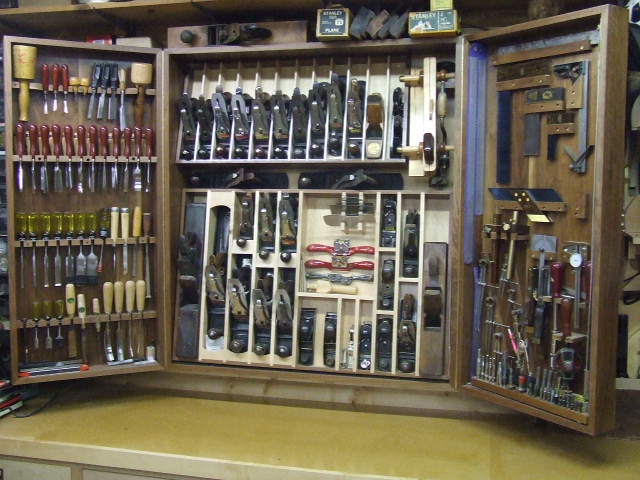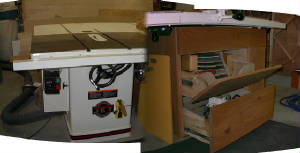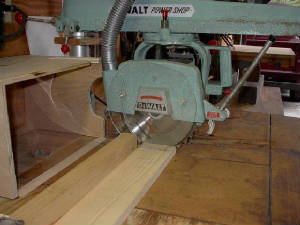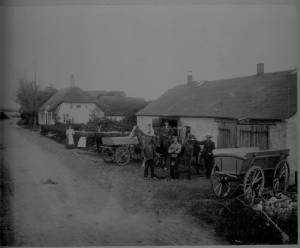Workshop Safety
In woodworking we should have a few tools to complete our work. Most of the tools that we will acquire will be power tools as well as hand tools so the first thing we need to consider is our own and others safety in operating them.Be sure and read all the saftey warnings with any tools purchased and practice those guidelines during any of your work. Don't become distracted when using any tool and make others who visit your shop aware of your safety concerns. Remember, you are in control of the tool, so practice of safe tool usage, work habits and workshop surroundings will help minimise any serious injury.
Throughout the time I've been woodworking I have developed my own skills and techniques and have learned the extent and capabilities of the tools I use. Within this site are many tips and jigs I use or have designed to aid my work and better my skills, use them to develop your own skills.
Hand Tools
Hand tools are the mainstay of any shop and a good assortrment compliments any shop. If you are a first time woodworker picking out the appropriate hand tools for any given project can be confusing as the variety of tools on the market is enormous and can be quite confusing to a first time buyer. I found it best to talk to the suppliers locally or thru the woodworking forums to see what others in the field like or dislike. I found it most helpful if I could put my hands on the tool of interest and more than helpful enabling me to feel first hand if the tool felt comfortable in hand, something very important as you want the purchase to be of value to you but not an asset laying in the shop gathering dust because it doesn't feel comfortable to use.
Here is a basic that should help you to choose and inventory as you acquire your tools. There's is also an excellent article in Woodworking Basics to assist in your research.

The Cabinet Saw is the main workhorse in any shop and quite a bit more versatile in functions and cutting operations. After many years working with the radial arm saw and a small table saw, I figured it was time for an upgrade. After many days and nights of research and narrowing it down to three choices, I was given a proposal from an affiliate woodworking chain that outweighed any other in price and satisfied my needs in the shop with the allocated space I had. The Jet 3HP Left Tilt Cabinet Saw has been a real workhorse and with the additions of the outfeed table, under table cabinet storage and the sanding downdraft table, it has proved to be a roomy work center. Further pictures and articles throughout the site will highlight the additions as well as the jigs that make the equipment so versatile. Any new woodworker should consider this style saw in his future arsenal of tools.


This is one of the main pieces of equipment in the shop.It is a 1960's Dewalt 925H Radial Arm Saw which originally belonged to my father. It is in original condition with the only modification being a blade guard addition for safety. Having grown up with this saw as the main piece of equipment to work with, I feel it is a very useful addition to any shop. Although many debate it's use and over time the sliding miter saw has become more popular, it has many features that would benefit you in your shop. If you choose to add this to your shop collection try to purchase one of the older Dewalt, Delta or Original Saw machines. You will find it useful in cutting deep dado's, molding and especially cuting odd angles. It does require regular maintenance in cleaning and lubrication and checking the alignment periodically but mine has been minimal. It's pull stroke design tends to shy people away from using it but with a proper NEGATIVE hook blade and proper safety procedures it can become a valuable tool.
For those interested in more information on the Radial Arm Saw I found this to be of interest;
Unlike most types of woodworking machinery, the radial arm saw has a clear genesis: it was invented by of . De Walt applied for in , which were issued in . De Walt and others subsequently patented many variations on the original, but De Walt's original design (sold under the moniker Wonder Worker) remained the most successful: a circular sawblade directly driven by a held in a sliding along a horizontal arm that is some distance above a horizontal table surface.
Beginning about the late , the compound began to replace the radial arm saw. The radial arm saw is less safe, especially when used by an inexperienced or untrained operator.
Retrieved from "
"
Below are a couple instruction files for Radial Arm Saw usage which will be helpful to anyone owning or thinking of investing in this piece of equipment. Further information can be obtained at .
